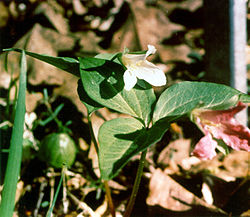| Persistent trillium | |
|---|---|
 | |
| Scientific classification | |
| Kingdom: | Plantae |
| Clade: | Tracheophytes |
| Clade: | Angiosperms |
| Clade: | Monocots |
| Order: | Liliales |
| Family: | Melanthiaceae |
| Genus: | Trillium |
| Species: | T. persistens |
| Binomial name | |
| Trillium persistens Duncan, 1971 | |
Trillium persistens, the persistent trillium, is a North American species of flowering plants in the genus Trillium of family Melanthiaceae (formerly Trilliaceae). The plant is also called the persistent wakerobin. [3] [4]
Persistent trillium is an endangered herbaceous perennial plant that grows to a height of 20–30 cm, with three leaves in a whorl near the top of the stem just below the flower; each leaf is broad lanceolate, 3–9 cm long and 1.5–3.5 cm broad. The white flower has three petals, each petal 2–3.5 cm long and 0.5–1 cm broad. [5]
This plant has a limited range in parts of the United States in the northeastern Georgia and northwestern South Carolina. [6]


